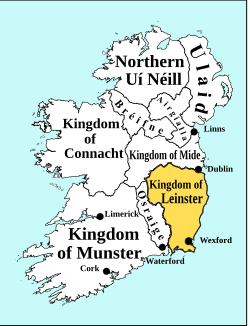This article needs additional citations for verification. (May 2023) |
Kingdom of Leinster Laighin | |||||||||||||
|---|---|---|---|---|---|---|---|---|---|---|---|---|---|
| 7th century BC–1603 | |||||||||||||
The Mac Murchadha Caomhánach as leaders of the Laigin provided many kings of Leinster.
| |||||||||||||
 A map of Leinster in the 10th century, with boundaries accounting for the loss of Osraige. | |||||||||||||
| Capital | Ferns Naas, Mullaghmast & Lyons (rotational) Dún Ailinne (ancientl) | ||||||||||||
| Common languages | Primitive Irish, Old Irish, Middle Irish, Latin | ||||||||||||
| Religion | Gaelic Christianity Catholic Christianity Gaelic tradition | ||||||||||||
| Government | Tanistry | ||||||||||||
| Rí | |||||||||||||
• 634–594 BC | Úgaine Mór | ||||||||||||
• 1603 | Domhnall Spáinneach Mac Murchadha Caomhánach | ||||||||||||
| History | |||||||||||||
• Established | 7th century BC | ||||||||||||
• Disestablished | 1603 | ||||||||||||
| ISO 3166 code | IE | ||||||||||||
| |||||||||||||
| Today part of | Ireland | ||||||||||||
The Kingdom of Leinster (Irish: Ríocht Laighean) was a kingdom of Gaelic Ireland which existed in the east of the island from the Irish Iron Age until the 17th century Early Modern Ireland. According to traditional Irish history found in the Annals of the Four Masters, the kingdom was founded as the territory of the Laighin, a Heremonian tribe of Irish Gaels. Some of the early kings of Leinster were also High Kings of Ireland and Kings of Tara, such as Úgaine Mór, Labraid Loingsech and Cathair Mór.
The Leinstermen had originally achieved hegemony in Ireland to the detriment of the Ulster-based Érainn, another group of Irish Gaels, but eventually lost out to their kinsmen the Connachta. This fall from power had lasting consequences in terms of territory for Leinster, as the Southern Uí Néill carved out the Kingdom of Meath to the north, and control of Osraige to the west was lost to the Corcu Loígde, becoming part of the Kingdom of Munster. The kingdom had different borders and internal divisions at different times during its history.
During the 5th to the early 8th centuries, the Kingship of Leinster was contested by various different branches of the Laighín, including the Uí Cheinnselaig (ancestors of the Mac Murchada and Ó Tuathail),[1][2] the Uí Bairrche (ancestors of the Mac Gormáin), the Uí Máil (ancestors of the Ó Conchobhair Uí Failghe) and others. Following this period, until the 11th century, Leinster was mostly contested between two branches of the Uí Dúnlainge kinship, represented by what are today the families of Ó Tuathail and Ó Brion. In the 9th century, the Laighín also regained control of Osraige but it remained a largely independent realm under the Mac Giolla Phádrag.
Leinster had to contend with raids from the Vikings under the Uí Ímair from the 9th century onwards, who established themselves at Dublin and Wexford. As part of these Gaelic-Viking battles, Murchad mac Diarmata, King of Leinster took control of the Kingdom of Dublin and the Kingdom of Mann and the Isles (what is now the Isle of Man and the Scottish Hebrides) for a brief period.[3] His father, Diarmait mac Máel na mBó, was the first Leinster High King of Ireland in centuries. This reversal in fortunes was brief, however, with the 12th century Norman invasion of Ireland seeing Leinster closely caught up in the affairs with Diarmait mac Murchada. In the longterm Leinster lost territories to the Normans, which became the Pale as the administrative centre of the Kingdom of England's Lordship of Ireland, as well as the Earldom of Kildare to the FitzGerald dynasty. This did not mean the end of Leinster, however and the kingdom continued to control much of what is today County Wexford and County Carlow and parts of County Wicklow until the early 17th century when it became part of the Tudor Kingdom of Ireland, later being revived as the Province of Leinster.
- ^ "MacMorough family genealogy". LibraryIreland.com. Retrieved on 26 July 2009.
- ^ "O'Toole (No.1) family genealogy". LibraryIreland.com. Retrieved on 26 July 2009.
- ^ Duffy (1992) pp. 100–01

